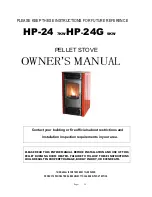
User manual MIA 90
Page102
Vers. 1 du 20/10/16
EN
Combustion
Combustion is a chemical reaction in which two reactants, called fuel and oxidizer, combine generating thermal energy (heat) and producing
new substances (fumes).
To understand the expression described above, we consider this practical scheme named "combustion triangle"; it consists of three
elements that are necessary to have the combustion reaction. These three elements are:
• fuel (pellets)
• oxidizing agent (oxygen in air)
• trigger (Heat)
The reaction between the fuel and the oxidizing agent is not spontaneous, but occurs using an external trigger that is a heat source, flame
or spark. The trigger represents the ignition energy necessary for the reagent molecules to start the reaction. With the cooker off, this
energy must be supplied from an external source (Electrical ignition coil). Then, the energy released by the reaction makes selfsustainment
possible (brazier and high temperature in the combustion chamber).
The fuel and the oxidizing agent must be in adequate proportions because combustion is restricted to the so-called “inflammability field”.
Three types of combustion are reported below, the correct one is reported in Figure 3:
INCORRECT combustion, flame too drawn, in “blowtorch” style with a high quality of
incandescent pellets coming out of the brazier. Correct the pellet/air set by reducing the
percentage of air (from 0 to -5); if not sufficient, also increase the percentage of falling
pellets (from 0 to +5) to arrive to the condition in Figure 3.
If the changes made to the settings do not bring the stove to the right combustion conditions
in Figure 3, contact the Technical Support Centre.
INCORRECT combustion, “spring” flame in “wood stove” style with high quantity of pellets
not burning on the brazier. Firstly, check the door is closed and the ash pan. Secondly,
correct the pellet/air set by increasing the percentage of air (from 0 to +5); if not sufficient,
also reduce the percentage of falling pellets (from 0 to -5) to arrive to the condition in Figure
3.
If the changes made to the settings do not bring the stove to the right combustion conditions
in Figure 3, contact the Technical Support Centre.
CORRECT combustion, lively yellow/white flame with a minimum quantity of pellets on the
brazier.
Ideal combustion which does not require changes.
Figure 3 shows a flame produced by a stove with operating power set to maximum value.
Fig. 1
Fig. 2
Fig. 3
OXYGEN
HEA
T
FUEL
Safety devices
The cooker is equipped with sophisticated safety systems, which avoid damage to the cooker and/or the home in the event of breakage
of a single piece or faults on the flue. In any case, if an anomaly occurs, the pellets are immediately stopped from falling and the switch
off phase activates.
The corresponding alarm is shown on the display. It is possible to see the details in the chapter dedicated to alarms.
Regulations, directives and Technical standards
All Aico SpA products are manufactured according to the regu-
lation:
•
305/2011
manufacturing materials
according to the guidelines:
•
2014/30 UE
Electromagnetic Compatibility (EMC)
•
2014/35 UE
Low voltage electric safety (LVD)
•
2011/65 UE
RoHS 2
•
2014/53 UE
Radio
And according to the standards:
• EN 14785
• EN 50165
• EN 62233
• EN 60335-1
• EN 60335-2-102
• EN 61000-3-2
• EN 61000-3-3
• EN 55014-1
• EN 55014-2
• ETSI EN 300220-1
Summary of Contents for MIA 90
Page 1: ...MANUALE UTENTE MIA 90 MANUEL DE L UTILISATEUR MIA 90 USER MANUAL MIA 90...
Page 49: ...DATA INTERVENTO EFFETTUATO MANUTENZIONE...
Page 95: ...DATE INTERVENTION FFECTU E ENTRETIEN...
Page 96: ...Stove model Stove serial number Date of installation Support reference data Telephone number...
















































